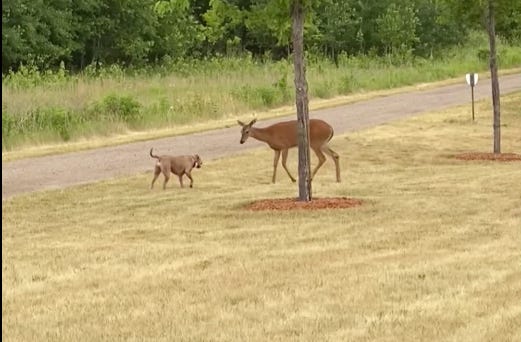'The grandkids love them': Rare, unusual-looking deer become pets for Pennsylvania family

STROUDSBURG, Pa. — While many families enjoy cats and dogs, a family in northeastern Pennsylvania discovered deer can be great pets, too.
Ralph Petricone and Renee Winslow have six deer roaming in their yard and sometimes in their home.
Winslow first became interested in raising the animals when a young deer was made available about 11 years ago through a petting zoo. “She fell in love with it and had to have it,” Petricone said.
After receiving the proper permitting through Pennsylvania Department of Agriculture, the white-tailed deer with white markings known as a piebald soon moved into their home.
The Pennsylvania Department of Agriculture oversees privately owned deer farms called Cervidae Livestock Operations. They are an agricultural operation in which privately owned members of the Family Cervidae (deer) are held in captivity.
The deer, which they named “Pie,” for its unique coloring, spent a lot of time in their home but now roams a 3-acre, fenced-in area.
A year later, Petricone said his wife realized they enjoyed having deer as pets so much that they decided to have more. They found someone with a young buck, and it didn’t take long before the deer reproduced. Now they have six whitetails, and five of them have the white piebald genetic traits.
Albino deer are all white and lack pigmentation in their hooves and eyes. The piebald genetic abnormality can create defects — three of this family’s deer becoming deaf.
He said the deaf deer are calm and gentle as they aren’t as easily spooked as normal deer that have sensitive hearing.
“They are all very gentle," Petricone said. “You can pet every one of them; they’ll come up. The grandkids love them. They can put their arms around their heads.
"… They actually make great pets but only if you put the time in and bottle raise them and raise them up from fawns yourself.”
The deer are playful in the yard and he said it’s easy to create a bond with them. He recalled when the deer used an old tarp to play on similar to a children’s slip and slide. “They’re fun animals,” he said.
To help keep the deer safe from coyotes and bear that may try to navigate through the fence, they have two herding type dogs, an Anatolian and a Kangal, that watch over the small herd.
They’ve grown attached to the deer as each one has different markings and personality. “They are interesting looking,” he said about the piebalds but wished they didn’t have genetic defects. “Nature takes its own course. ... Each one gets its own special attention.”
The deer have reproduced and some offspring are piebalds. When they have too many, they are able to sell them to other licensed handlers. One time he traded a somewhat aggressive buck to a fisherman for some seafood. “I traded him for one tuna, 20 lobsters and 30 pounds of shark meat,” Petricone said.
Due to strict state regulations on captive deer, they have a sturdy fence around 3 acres of their property to prevent the deer from escaping. With concerns about Chronic Wasting Disease in deer, Petricone said, if animals escaped they would have to be euthanized to prevent a possible conflict with the wild population.
While the deer are unique pets in themselves, the family also has a propagation permit through the Pennsylvania Game Commission for gray fox. They have two foxes, named Taz and Tildy, that sometimes spend time in their home like more traditional pets. One is 9 and the other is 8, and they raised them from pups.
For those thinking about owning a deer, Petricone said to do your research and visit a place that is licensed to have deer. He said it can be expensive purchasing the feed and paying for vet bills for deer.
“They’re eating constantly,” he said.
“Think about how much work and time you can devote to it," Petricone said about the never-ending commitment it takes to care for large animals. "It’s got to be something you really want. … Don’t get it unless you really want it bad.”
He also suggests starting with a doe. The bucks become aggressive in the early fall when the mating season approaches.
Brian Whipkey is the outdoor columnist for Paste BN Network sites in Pennsylvania. Follow him on Twitter: @whipkeyoutdoors.